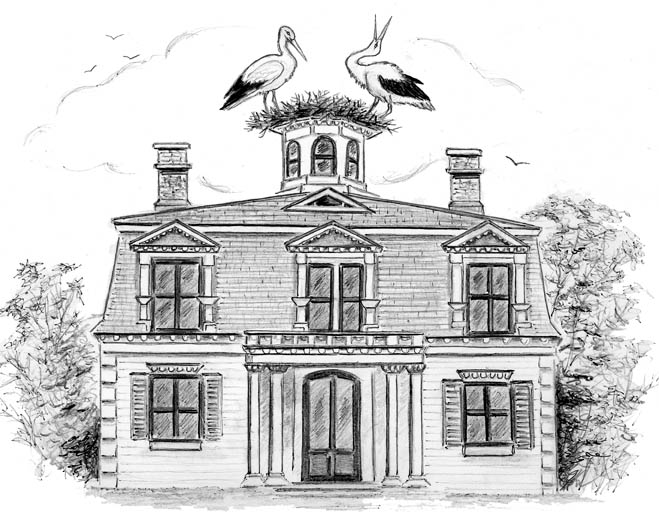
Dear Bird Folks,
What is going on at the Captain Penniman House at the Fort Hill site (Eastham, MA)? On top of the widow’s walk some Park Service employees appear to be building a large nest. Is the nest for Ospreys, and if so, why can’t the Ospreys build their own nest like they do everywhere else?
– Mel, Eastham, MA
You are right, Mel,
Ospreys are more than capable of building their own nests, but this nest isn’t for Ospreys. Also, it isn’t being built by the National Park Service. It’s being built by the US State Department. What? This project also caught my eye, so last week I stopped to see what was going on. That’s when I found out who is running the project. That’s also when I found out that State Dept. folks don’t like to answer questions. A well-dressed guy, whose badge told me his name is A.F. Dae, said that the construction is for the “Stork Project” and that’s all he’d tell me. When I asked for more information, he gave me a look that was cold enough to stop global warming. With plenty of sarcasm I said, “Thanks for all your help” and then bid good day to Mr. Dae. But as soon as I got into my car I started calling around. I was determined to find out what was going on and believe me, I found out plenty.
The large nest that is being constructed on top of the Captain Penniman House is for White Storks. White Storks (not to be confused with North America’s Wood Storks) are those large white birds that build massive stick nests on top of barns and chimneys throughout much of Europe. White Storks have long been the featured birds in many children’s fairy tales and cartoons. They are the birds that some parents have used to explain childbirth. (My mother still insists that’s where I came from.)
White Storks are tall, long-legged birds that are about the size of our Sandhill Cranes. Most storks spend the winter in Africa and travel to Europe each spring to raise their families. Historically, farmers have encouraged storks to nest on their property by attaching platforms to the roofs of their homes and barns. In return for their hospitality, the cranes consume large amounts of harmful insects and rodents from the farmers’ fields. The birds also provide the locals with some much-needed entertainment. A pair of storks will habitually greet each other by tipping their heads back and giving out loud, rapid-fire bill snaps.
For centuries is has been considered good luck for a village to have a pair of White Storks nesting within its boundaries. Unfortunately, most villages now have to make do without their good luck birds. The population of White Storks has plummeted in recent years. Habitat changes and pesticides have caused their share of problems, but the real menace facing the birds is migration. The birds must fly over countries with weak environmental laws. Many of these majestic birds are nothing more than flying targets for anyone with a gun. In the Netherlands alone the population of storks has gone from 500 nesting pairs to fewer than ten. Authorities are desperate for a solution. This is where we come in.
In 1785, Ben Franklin, a man obsessed with Wild Turkeys, was worried that turkeys were on their way to extinction. In an effort to save the birds, Franklin shipped two dozen live turkeys to the Netherlands, after reaching a quid pro quo agreement with their leader, Prince Willem IV. Old Ben was hoping to establish a second population of Wild Turkeys on the European mainland in case all of our birds ended up stuffed and covered in gravy. (I told you, Franklin was obsessed with turkeys.) In an ironic twist, the exported turkey population only survived a few years, while the North American population is now healthier than ever. However, the irony doesn’t end there. The Dutch government is now cashing in its quid pro quo chip. They are asking the United States to help them establish a secondary flock of White Storks before their birds become extinct.
Next week, at the end of an elaborate ceremony, a mated pair of White Storks will be released on the top of Fort Hill in Eastham. It is hoped that the birds will readily adapt to the surrounding fields and marshes, which are very similar to those in their homeland. Understandably, the Park Service is not happy with this plan, but it seems they have no authority over the US State Department, or over Prince Willem IV. On the positive side, the storks’ mating theatrics are totally fascinating and their antics should be a huge draw and a welcomed boost to the local economy.
The list of dignitaries attending the ceremony will include representatives of the Dutch Government, a big shot from the US State Dept (Hillary?), plus a descendant of Benjamin Franklin. The ceremony is open to the public, but anyone attending is asked to bring a replica of the Dutch flag. Dutch flags are easy to make; they look exactly like those red, white and blue open flags we see everywhere, but without the insulting “open” written on them. The stork release ceremony should be quite an event. It takes place on the top of Fort Hill at 12:30 PM, this Thursday, April 1st.